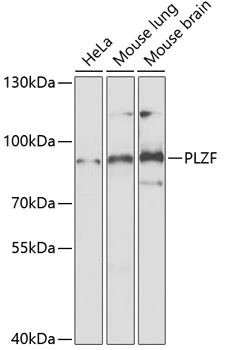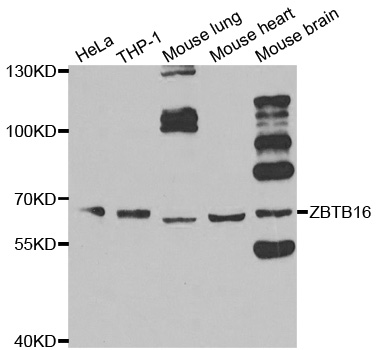PLZF antibody [N1N3]
GTX111046
ApplicationsImmunoFluorescence, Western Blot, ImmunoCytoChemistry, ImmunoHistoChemistry, ImmunoHistoChemistry Frozen
Product group Antibodies
TargetZBTB16
Overview
- SupplierGeneTex
- Product NamePLZF antibody [N1N3]
- Delivery Days Customer9
- Application Supplier NoteWB: 1:500-1:3000. ICC/IF: 1:100-1:2000. *Optimal dilutions/concentrations should be determined by the researcher.Not tested in other applications.
- ApplicationsImmunoFluorescence, Western Blot, ImmunoCytoChemistry, ImmunoHistoChemistry, ImmunoHistoChemistry Frozen
- CertificationResearch Use Only
- ClonalityPolyclonal
- Concentration1.03 mg/ml
- ConjugateUnconjugated
- Gene ID7704
- Target nameZBTB16
- Target descriptionzinc finger and BTB domain containing 16
- Target synonymsPLZF, ZNF145, zinc finger and BTB domain-containing protein 16, promyelocytic leukaemia zinc finger, zinc finger protein 145 (Kruppel-like, expressed in promyelocytic leukemia), zinc finger protein PLZF
- HostRabbit
- IsotypeIgG
- Protein IDQ05516
- Protein NameZinc finger and BTB domain-containing protein 16
- Scientific DescriptionThis gene is a member of the Krueppel C2H2-type zinc-finger protein family and encodes a zinc finger transcription factor that contains nine Kruppel-type zinc finger domains at the carboxyl terminus. This protein is located in the nucleus, is involved in cell cycle progression, and interacts with a histone deacetylase. Specific instances of aberrant gene rearrangement at this locus have been associated with acute promyelocytic leukemia (APL). Alternate transcriptional splice variants have been characterized. [provided by RefSeq]
- Storage Instruction-20°C or -80°C,2°C to 8°C
- UNSPSC12352203
References
- Thalidomide and its metabolite 5-hydroxythalidomide induce teratogenicity via the cereblon neosubstrate PLZF. Yamanaka S et al., 2021 Feb 15, EMBO JRead more


![ICC/IF analysis of HeLa cells using GTX82804 PLZF antibody [5B3]. Green : PLZF Red: Actin filaments](https://www.genetex.com/upload/website/prouct_img/normal/GTX82804/GTX82804_20170912_ICCIF_w_23061322_404.webp)




